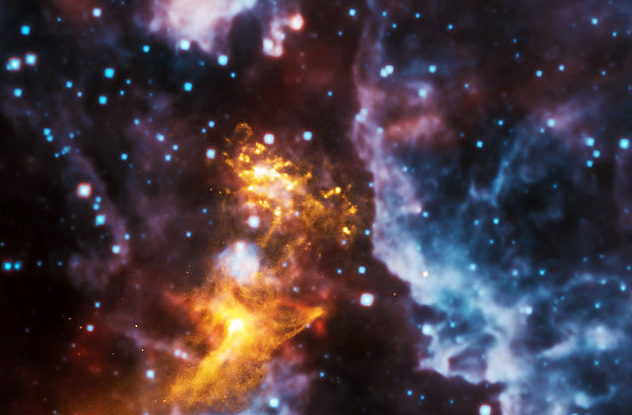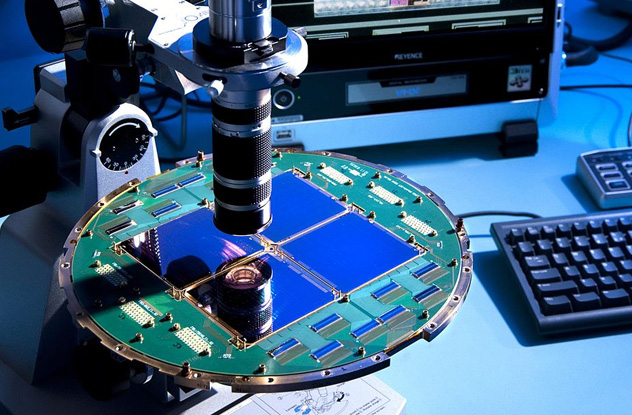 Movies and TV
Movies and TV  Movies and TV
Movies and TV  Humans
Humans 10 Times Scientists Were Absolutely Sure… and Absolutely Wrong
 Our World
Our World 10 Pivotal Moments for Life on Earth
 Movies and TV
Movies and TV 10 Most Realistic Medical TV Shows of All Time
 Creepy
Creepy 10 Eerie & Mysterious Ghosts of the Pacific Coast
 Weird Stuff
Weird Stuff 10 Typos That Accidentally Changed History
 History
History 10 Times Trickery Won Battles
 Technology
Technology 10 Awesome Upgrades to Common Household Items
 Misconceptions
Misconceptions 10 Hilarious (and Totally Wrong) Misconceptions About Childbirth
 Weird Stuff
Weird Stuff 10 Warning Labels That Exist Because Someone Actually Tried It
 Movies and TV
Movies and TV 10 Zombie Movies That Will Actually Terrify You
 Humans
Humans 10 Times Scientists Were Absolutely Sure… and Absolutely Wrong
 Our World
Our World 10 Pivotal Moments for Life on Earth
Who's Behind Listverse?

Jamie Frater
Head Editor
Jamie founded Listverse due to an insatiable desire to share fascinating, obscure, and bizarre facts. He has been a guest speaker on numerous national radio and television stations and is a five time published author.
More About Us Movies and TV
Movies and TV 10 Most Realistic Medical TV Shows of All Time
 Creepy
Creepy 10 Eerie & Mysterious Ghosts of the Pacific Coast
 Weird Stuff
Weird Stuff 10 Typos That Accidentally Changed History
 History
History 10 Times Trickery Won Battles
 Technology
Technology 10 Awesome Upgrades to Common Household Items
 Misconceptions
Misconceptions 10 Hilarious (and Totally Wrong) Misconceptions About Childbirth
 Weird Stuff
Weird Stuff 10 Warning Labels That Exist Because Someone Actually Tried It
10 Ways Black Holes Continue To Surprise Us
A black hole is a large amount of matter squeezed into a tiny area with an enormous gravitational pull for its size. Many black holes form from dying giant stars that collapse in on themselves. But even as black holes, they continue to orbit and exert the same gravitational pull on objects around them.
Visualize it this way. If the Earth became a black hole (which it couldn’t), it would weigh the same as it does today, but its size would be smaller than a human eyeball. However, that eyeball would have the same gravitational pull, so the Moon would keep orbiting around it.
You wouldn’t see the black hole directly because the boundary around its mouth (called the “event horizon”) traps light inside. But like invisible wind that causes trees to bend and sway, we believe black holes are there because of their effect on their surroundings.
Not all scientists believe in black holes. But for those who do, the surprises just keep coming.
10Our Early Ancestors May Have Seen The Milky Way’s Black Hole

Around two million years ago, the supermassive black hole at the center of our galaxy burst into life with a radiant glow. At that time, man was just beginning to walk upright. Our ancestors would have seen a moon-sized light in the southern sky that looked like a bright fuzz ball or smudge.
Our black hole, Sagittarius A*, is quiet now. But back then, it was believed to be an active galactic nucleus (AGN), the energy-producing compact center of a galaxy that greatly outshines the rest of it. A feeding black hole may be the source of an AGN as its gravitational pull attracts matter, forming a disk that heats up and glows. If the disk pulls in large amounts of matter, two bright jets of high-energy particles will be cast off from the black hole perpendicular to its spin.
Astronomers devised this AGN theory in 2010 after spotting two Fermi bubbles stretching 25,000 light-years above and below our galaxy. The scientists believe that AGN jets could have produced those bubbles between one and three million years ago.
The black hole light show would have lasted a few thousand years for our ancestors. According to anthropologist Chris Stringer, “It was the beginning of the genus Homo. Stone toolmaking had already begun, but the brain was only beginning to enlarge.” If Sagittarius A* goes AGN again, we may be treated to our own amazing light show in the night sky.
9Not Every Cosmic Powerhouse Is A Black Hole

For decades, many scientists believed that extremely bright X-ray sources, known as ultraluminous X-ray (ULX) sources, had to be caused by black holes eating stars or other matter.
When the immense gravity of a black hole attracts the gas of a nearby star, that gas spirals down to form an accretion disk around the black hole. Like water circling before it goes down the drain, the gas accelerates greatly, heating to extremely high temperatures that release bright X-ray light in every direction. The larger the feeding black hole, the more it consumes, and the brighter the light.
That was the theory. Then, in nearby galaxy M82, astronomers accidentally discovered a ULX source that pulsed, emitting a bright X-ray beam that swept past Earth every 1.37 seconds like a lighthouse beacon. The problem is, black holes don’t pulse. Pulsars pulse.
A pulsar is a spinning neutron star (the remnant of a dying star that wasn’t big enough to become a black hole) that emits X-ray light from its magnetic poles like the lighthouse beacon just described. But the pulsar in the M82 galaxy is 100 times brighter than its mass should permit according to a physics guideline called the Eddington limit. It shouldn’t be a ULX source.
“You might think of this pulsar as the Mighty Mouse of stellar remnants,” said Fiona Harrison of the California Institute of Technology. “It has all the power of a black hole with much less mass. The pulsar appears to be eating the equivalent of a black hole diet.”
Astronomers now have to reexamine other ULX sources to see if they pulse. They can no longer assume that every ULX source, or cosmic powerhouse, is a black hole.
8More Gluttonous Than Imagined

Until recently, scientists thought that the size of a black hole determined the top speed at which it could eat and produce light (the Eddington limit). Then they discovered P13, a black hole in the galaxy NGC7793, which rotates around a supergiant star while cannibalizing it. But P13 is gorging itself on its companion star’s gas 10 times faster than astronomers believed possible.
P13 is believed to be 15 times smaller than our sun yet a million times brighter. It has the ability to devour its companion star in less than a million years, which is fast in cosmic time.
This small black hole consumes matter with a weight equal to 100 billion billion hot dogs every minute. “As hot dog–eating legend Takeru Kobayashi famously showed us, size does not always matter in the world of competitive eating, and even small black holes can eat gas at an exceptional rate,” said astronomer Dr. Roberto Soria.
Like the M82 pulsar, P13 is an ultraluminous X-ray source that not only violates the Eddington limit—it knocks it out of the galaxy. Astronomers now realize that there may not be a strict limit on how much a black hole can eat.
7Supermassive Black Holes May Be More Numerous Than We Thought

Black holes come in a variety of sizes, from primordial (which may be as small as one atom) to supermassive (with masses larger than one million suns packed into the size of a solar system). There may even be a rare extra-large size called ultramassive.
At one time, only larger galaxies were believed to contain massive black holes. But in early 2014, astronomers revealed that over 100 small dwarf galaxies appear to have massive black holes at their centers. Compared to our Milky Way’s collection of 200–400 billion stars, a dwarf galaxy has only a few billion stars and far less mass.
Then, in September 2014, astronomers announced that they’d found a supermassive black hole in an ultracompact dwarf galaxy called M60-UCD1, the densest galaxy currently known. If you lived in M60-UCD1, you’d see at least one million stars in the night sky as opposed to the 4,000 stars we see from Earth with the naked eye.
Although the Milky Way’s central black hole has a mass of four million suns, it’s less than 0.01 percent of our galaxy’s total mass. By comparison, M60-UCD1’s central black hole is a monster, with a mass of 21 million suns that’s 15 percent of its galaxy’s total mass.
Based on these findings, some astronomers believe that many ultracompact dwarf galaxies may be the remains of larger galaxies that were torn apart when they collided with other galaxies. So there may be as many supermassive black holes in the centers of ultracompact dwarf galaxies as there are in larger galaxies.
6Gobbling Mass Like A Baby Pac-Man

Quasars are the brilliant centers of the most distant galaxies we can see in our universe. They’re believed to be supermassive black holes with accretion disks that blast out incredibly bright X-ray light. Quasars can shine up to two trillion times brighter than our sun. They may be billions of light-years away from Earth. To look at a quasar is to look back in time at its baby photo.
Scientists have puzzled over how an early black hole could begin life at an estimated 10 solar masses then quickly grow to more than one billion solar masses shortly after the big bang. Under normal conditions, gas pulled toward a black hole spirals down to form an accretion disk. Some gas trickles inside, but several processes usually slow the growth of a black hole.
Researchers believe the early universe contained cold gas streams that were much more dense than exist today. A young black hole would have moved quickly, continually changing direction like a gobbling baby Pac-Man as nearby baby stars knocked it around. These fast directional changes may have let the black hole eat material directly from these denser gas streams so quickly that the slow spiral never happened. As the black hole grew, it ate even faster. In a cosmically quick 10 million years, the black hole would have grown from 10 solar masses to 10,000 solar masses. Then the growth rate would have slowed. But the path to a weight of at least one billion solar masses would have been locked in.
5Black Holes May Prevent Star Formation

In mature galaxies, researchers discovered that massive black holes can stop the development of baby stars by spewing out particles that emit radio waves. Traveling near the speed of light, these heated jets act like off switches to stop hot gas in the galaxy from cooling and condensing into new stars. Scientists don’t know why central black holes in these older, often elliptical, galaxies begin to emit these particles.
But until recently, they believed that massive central black holes were always to blame for “red and dead galaxies,” which consist of older stars only. Then they discovered several compact, young galaxies that are dying prematurely. These young galaxies have the mass of the Milky Way squeezed into a relatively small area.
Based on their research, a team of astronomers believe that these stars are responsible for flipping their own off switch in these younger galaxies. A burst of star-making activity appears to begin with the collision of two gas-rich galaxies that funnel lots of cold gas into the compact center of the merged galaxy. Then the energy from this frenzied birthing activity may blast out any leftover gas, which shuts down future star formation. It’s also possible that the gas in these galaxies simply becomes too hot to cool and condense into new stars.
4The Eye Of Sauron Shows Black Holes Weigh More

Astronomers now think that supermassive black holes at the centers of galaxies have 40 percent more mass than originally believed. This may help to explain why the Eddington limit of brightness isn’t working with some current calculations of mass.
Researchers used a land-surveying technique to measure the distance to the NGC 4151 galaxy, whose active core is called the “Eye of Sauron” because it looks like its namesake from the Lord of the Rings movies. An earlier technique had estimated the distance from Earth to NGC 4151’s central black hole as 13 million–95 million light-years.
Scientists decided to use the twin Keck telescopes in Hawaii—and simpler mathematics—to get a result with almost 90-percent accuracy. NGC 4151’s black hole was active, feeding on nearby gas and producing X-ray light. This ultraviolet radiation then heated a dust ring orbiting the black hole. After 30 days, the dust would emit infrared radiation. Using the time of 30 days and the speed of light, the researchers computed the distance between the black hole and the ring of dust.
That distance was used to form the base of an isosceles triangle. After measuring the angle in the sky from the dust ring, the researchers used simple geometry to compute the distance to the Eye of Sauron as approximately 62 million light-years.
This much simpler technique now gives them the ability to measure the mass of supermassive black holes more precisely. Another use is to measure how fast the universe is expanding, which would help to determine the age of the universe.
3Explaining How Bumblebees Fly

Until recently, most gravitational researchers believed that space-time couldn’t be turbulent. But three scientists turned that belief on its head when they decided to analyze whether gravity could behave like a fluid. Under the right conditions, fluids are turbulent. Like cream stirred into your coffee, they may swirl and eddy instead of moving smoothly.
The researchers settled on fast-spinning black holes for their study. Space-time is less viscous around fast-spinning black holes, which increases the possibility of turbulence, similar to how water swirls more than molasses.
The results were surprising, even to them. “Over the past few years, we have gone from a serious doubt about whether gravity can ever go turbulent to pretty high confidence that it can,” said researcher Luis Lehner.
Before long, this may go from a theoretical finding to an observable one. New detectors may soon have the ability to detect gravitational waves, ripples in space-time that behave like waves in the ocean when a boat sails through it. In space, gravitational fluid may ripple from huge cosmic events such as two black holes colliding.
But these findings may also help us to understand turbulence here on Earth—including the physics of hurricanes, wind shear with airplanes, and the seemingly impossible flight of the bumblebee.
2 The Center Of A Galactic Murder Mystery

Some astronomers believe a murder mystery in space is turning pulsars into small black holes. It’s called the “missing pulsar problem.”
To recap, pulsars are spinning neutron stars (remnants of dying stars too small to become black holes) that emit bright radiation from their magnetic poles like a lighthouse beacon. With so many stars in our galaxy, at least 50 dead ones should be pulsars at the center of our Milky Way. But astronomers can find only one.
There are several possible explanations, but one of the most intriguing involves dark matter. Like black holes, dark matter is invisible and can only be detected by the way its gravitational pull interacts with other objects in space.
Two researchers have proposed that a pulsar’s gravity may attract certain particles of dark matter, causing that dark matter to swell the pulsar to such a large size that it collapses into a black hole. The pulsar becomes so big that it punches a hole through the fabric of space-time and disappears. “Dark matter can’t collect as densely or as quickly at the center of regular stars,” said researcher Joseph Bramante. “But in pulsars, the dark matter would collect into about a 2-meter [7 ft] ball. Then that ball collapses into a black hole, and it sucks up the pulsar.”
Some dark matter combines matter and antimatter in each particle. Those particles would destroy one another on contact. So the researchers believe that only asymmetric dark matter particles (which are either matter or antimatter but not both) can build up in a pulsar’s core over time.
There’s a greater concentration of dark matter at the galactic core, which may explain why pulsars are missing only in the center of our Milky Way.
1Our Universe May Have Spawned From A 4-D Black Hole

One big problem with the big bang theory is that our scientifically predictable universe originates from a singularity, an infinitely dense point that doesn’t play by the same rules of physics. Physicists don’t understand singularities. They can’t explain what sparked the big bang. Some physicists believe it’s unlikely that such a chaotic beginning would produce a universe with a largely uniform temperature.
So three researchers from the Perimeter Institute have proposed a new theory that they insist is mathematically sound and testable. They argue that our universe is the violently ejected outer material from the supernova death of a 4-D star whose inner layers collapsed into a black hole.
In our universe, a 3-D black hole has a 2-D event horizon, the boundary around the mouth of the black hole that represents the point of no return for anything that falls inside and gets trapped by gravity.
In a universe with four spatial dimensions, a 4-D black hole would have a 3-D event horizon. Our universe, the ejected material from the supernova, would form a 3-D membrane around the 3-D event horizon. That membrane’s growth is what we perceive as cosmic expansion. Our 3-D universe would have inherited the uniformity of the 4-D parent universe if that 4-D universe had existed for a long time.
The researchers are still refining their model. If we consider their theory absurd, they argue that that’s simply because we don’t understand a 4-D universe. Our thinking is limited by a 3-D world that may represent only the tip of reality.








